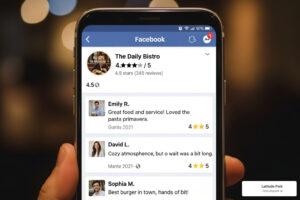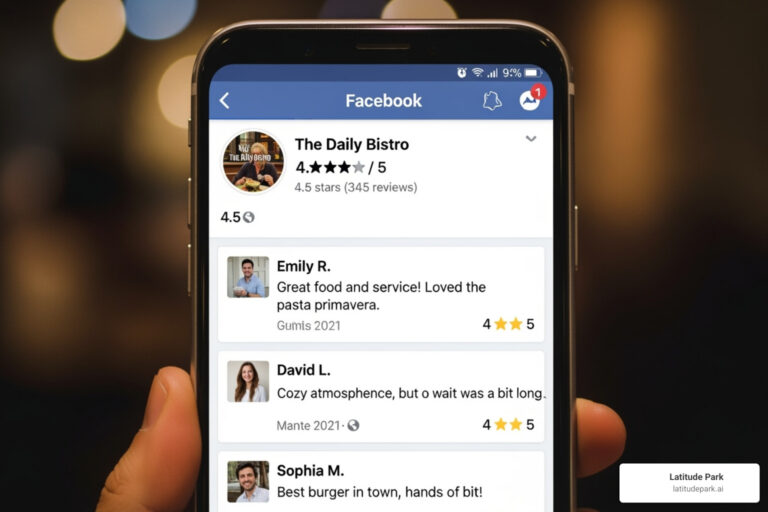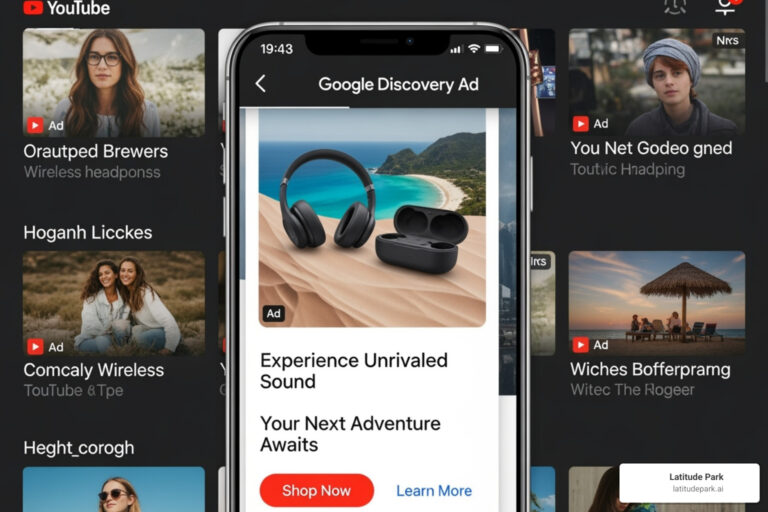When it comes to SEO for franchise websites, success boils down to striking a delicate balance. You're juggling the power of a national brand with the hyper-local marketing needed to get actual foot traffic through the doors of individual locations. It’s a genuinely complex strategy where corporate goals have to support—not stifle—local franchisee success.
The Unique Challenge of Franchise SEO
Franchise SEO presents a core conflict: how do you build a dominant national brand while still making sure each local franchisee can win in their own backyard? A generic, one-size-fits-all digital strategy just won't cut it. This dynamic creates a natural tension between corporate brand messaging and the very specific, on-the-ground needs of individual locations.
Think about a national fitness chain. A franchisee in Miami isn't just up against local boutique gyms; they might also be indirectly competing with another franchise location just a few miles away in Fort Lauderdale. Each one needs to rank for local searches like "best gym near me" or "personal training in Miami." That requires a completely different approach than the corporate goal of ranking for broad terms like "national fitness memberships."
This is where a unified strategy becomes critical. A well-executed program tracks metrics that show growth at both levels—overall brand traffic, local search visibility, and the total number of indexed franchise pages.
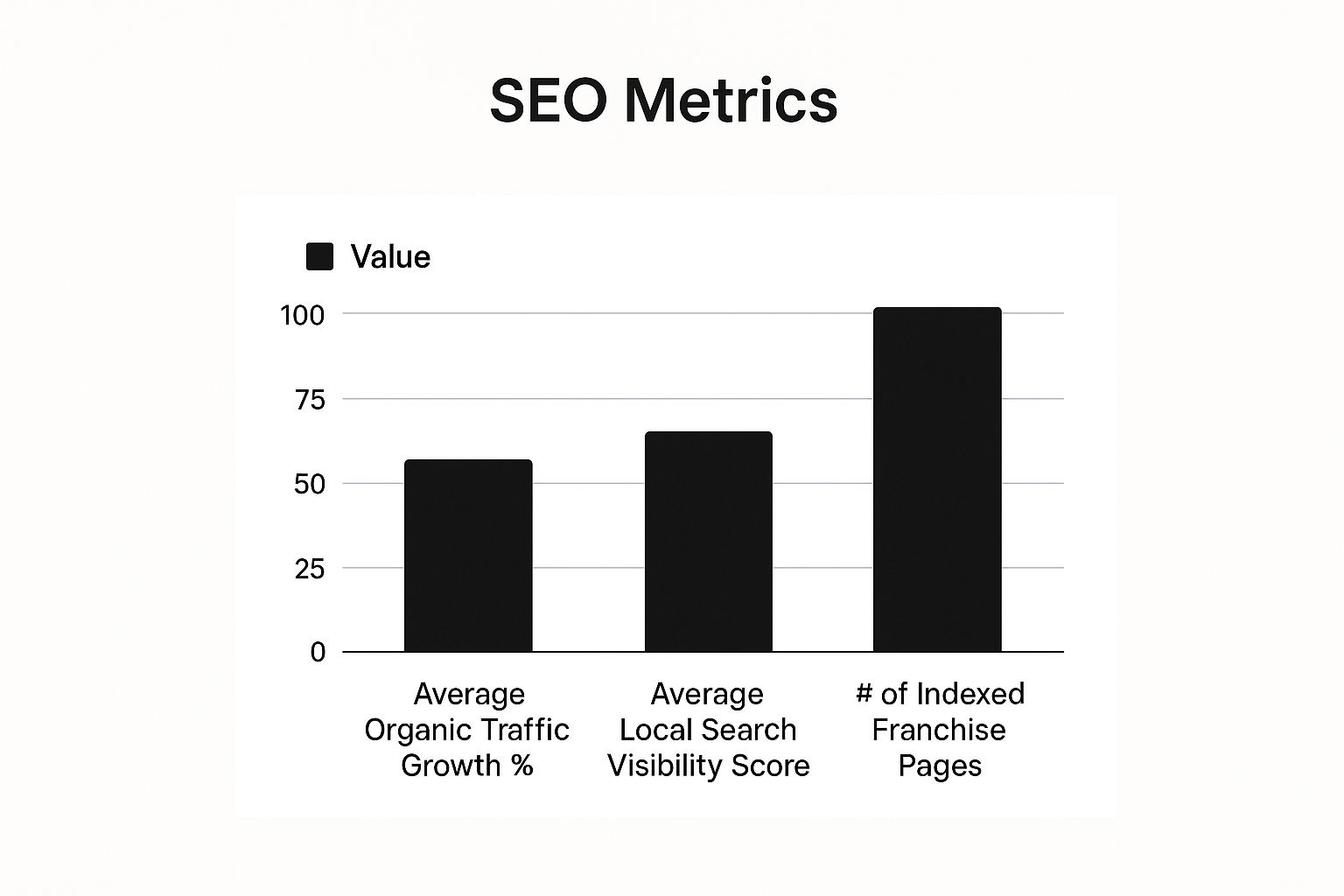
As you can see, the data shows how a cohesive strategy can boost brand-level authority and local performance across the entire network at the same time.
Navigating the Brand vs. Local Conflict
The key is to create a system that empowers local owners while simultaneously strengthening the parent company's digital footprint. At its heart, optimizing SEO for franchise websites is all about tackling this very challenge. This means digging deep into local keywords, creating unique content for each franchise site, and making it easy for customers to leave reviews.
This approach is more critical than ever, especially since 57% of local searches now happen on mobile devices. That stat alone underscores the need for a mobile-first design and lightning-fast websites. If you want to dive deeper, you can get more details on these strategies and their impact from industry experts.
The core challenge isn't just about outranking competitors; it's about structuring your online presence so your own franchisees don't cannibalize each other's search traffic. A successful strategy ensures each location has a clearly defined digital territory.
To help clarify this dynamic, it's useful to see a side-by-side comparison of where corporate and local efforts should focus.
Corporate SEO vs Franchisee Local SEO Focus
This table breaks down the different priorities. Corporate builds the powerful foundation, while franchisees bring that power to life on a local level.
| SEO Element | Corporate-Level Focus (Brand Authority) | Franchisee-Level Focus (Local Visibility) |
|---|---|---|
| Keyword Strategy | Broad, high-volume brand & industry terms (e.g., "national coffee chain") | Hyper-local, long-tail keywords (e.g., "best espresso near downtown Miami") |
| Content Focus | Brand story, company values, national promotions, product/service info | Location-specific events, local staff highlights, community involvement, testimonials |
| Link Building | Acquiring high-authority links from national publications and industry sites | Earning links from local news, blogs, community organizations, and business directories |
| Technical SEO | Managing the core domain, site architecture, and technical performance | Ensuring location pages are optimized and NAP (Name, Address, Phone) is consistent |
| Primary Goal | Build a powerful, authoritative brand that is recognized nationwide | Dominate local search results and drive foot traffic to a specific physical location |
Seeing the roles laid out this clearly helps everyone understand their part in the bigger picture.
A Unified Path Forward
So, how do you resolve this conflict? You build a system where corporate provides the foundational strength—a powerful domain, solid brand guidelines, and robust technical support. Franchisees then bring that strength to life with authentic local flavor.
We're talking about real photos of their specific location, customer testimonials from their community, and content about local events they sponsor. For example, a national pizza franchise's corporate site talks about its history and sourcing, while the local franchisee's page features a post about sponsoring the high school soccer team. This hybrid model allows the national brand to grow its authority while enabling each franchisee to connect with their local audience and truly dominate their market. This guide will give you the actionable advice you need to build that exact system.
Building Your Foundation with Local SEO Signals
Let's be clear: the true bedrock of SEO for any franchise is a rock-solid local presence for every single location. While your national brand provides the muscle, it's the individual, local signals that actually get customers in the door. This entire foundation starts with mastering your Google Business Profile (GBP).

Picture a customer frantically searching "emergency plumbing near me." Google's one and only mission is to serve up the most relevant, trustworthy, and closest option. A perfectly tuned GBP is your franchise's non-negotiable ticket to appearing in that coveted local map pack.
Mastering Your Google Business Profiles at Scale
For a single-location business, managing one GBP is pretty straightforward. But for a franchise with 50, 100, or even 1,000 locations? It becomes a monumental task where absolute consistency is king. Even tiny discrepancies can water down your local authority and confuse the heck out of search engines.
This is where franchise SEO gets serious. It demands an almost obsessive level of management over these profiles. Every single one has to be completely filled out and perfectly aligned—correct name, address, phone number (NAP), hours, and services. Inconsistent NAP data is a classic ranking killer, so using tools to keep this data squeaky clean is a must for scaling effectively. To really grasp the impact of data consistency, you can learn more about scaling franchise SEO efforts.
Your first job is a full-scale audit. Get a master spreadsheet going that lists every single franchise location and its core GBP data.
- Official Business Name: Is it "Brand Name of City" or "Brand Name – City"? Pick a format and lock it down across the board. For example, "QuickLube of Scottsdale" and "QuickLube – Tempe" is inconsistent.
- Physical Address: Hunt for little variations like "St." vs. "Street" or "Ste." vs. "Suite." Trust me, these details matter to Google. Use a tool like Google Sheets to find and replace these inconsistencies at scale.
- Local Phone Number: Every location needs its own unique, local number. Never, ever use a central 800 number. This is crucial for local search signals.
- Website URL: Double-check that each GBP links to the correct location-specific page on your main site, not the homepage.
yoursite.com/phoenixnotyoursite.com. - Primary Category: This one's a biggie. Your primary category (e.g., "Pizza Restaurant," "HVAC Contractor") has a massive impact. Make sure it's accurate and identical for all similar locations.
A classic mistake I see all the time is letting franchisees get "creative" with their business names on GBP—adding things like "Best" or the town's nickname. This is a direct violation of Google's guidelines and the inconsistencies will tank your rankings. Strict brand control over these profiles is simply non-negotiable.
Powering Up Profiles with Local Content
Once your foundational data is spotless, the real optimization work begins. A complete profile isn't just an accurate one; it’s one that’s rich with local, engaging content. This is how you show Google (and customers) the difference between a location in Miami and one in Milwaukee.
It's time to build a system for consistently adding locally relevant content to each and every profile.
- Locally-Shot Photos: Ditch the corporate stock images. Post high-quality photos of the actual storefront, the team on the job, and projects completed right there in the community. A local roofing franchise should post before-and-after photos of a roof they just replaced in that suburb. This builds immense trust and authenticity.
- Google Posts: Use this feature like a local bulletin board. Announce promotions, community events, or new services specific to that location. A "winter special" post for a Florida location just doesn't make sense, which perfectly highlights why this local touch is so vital. A better example is "20% Off AC Tune-Ups for Phoenix Residents This Week Only."
- Q&A Seeding: Don't wait for customers to ask questions. Proactively populate the Questions & Answers section yourself. Add common queries ("Do you offer free estimates?" or "Are you open on Sundays?") and provide clear, helpful answers. This removes friction for potential customers and positions you as the expert.
Building a Local Review Machine
Positive reviews are easily one of the most powerful local ranking factors. A steady stream of recent, positive feedback signals to Google that a specific franchise location is active, trusted, and valued by its community. Simply waiting for reviews to trickle in organically isn't a strategy—it's a missed opportunity.
You need to build a system to actively solicit them. For a home services franchise, for instance, an automated process might look like this:
- Job Completion: A technician marks a job as complete in their field software (like ServiceTitan or Jobber).
- Automated Text/Email: This action triggers an automated message to the customer, simply asking about their experience. "Hi [Customer Name], how was your service with [Technician Name] today?"
- Direct to Review: If the feedback is positive, the system follows up with a direct link to that location’s Google Business Profile review page. This makes it incredibly easy for a happy customer to share their praise.
This proactive approach turns customer satisfaction into a tangible SEO asset. By mastering your GBP data, enriching profiles with real local content, and systematically generating reviews, you build an incredibly powerful and resilient foundation for your entire SEO for franchise websites strategy. This ensures every single location can compete—and win—in its own backyard.
Structuring Your Website for SEO Success
Getting your website’s technical structure right is one of the most important decisions you'll make for your franchise's SEO. I can't overstate this. How you set it up determines how Google sees your brand, how authority flows to your locations, and how easily customers can find their nearest franchisee. It's the digital foundation for everything else.
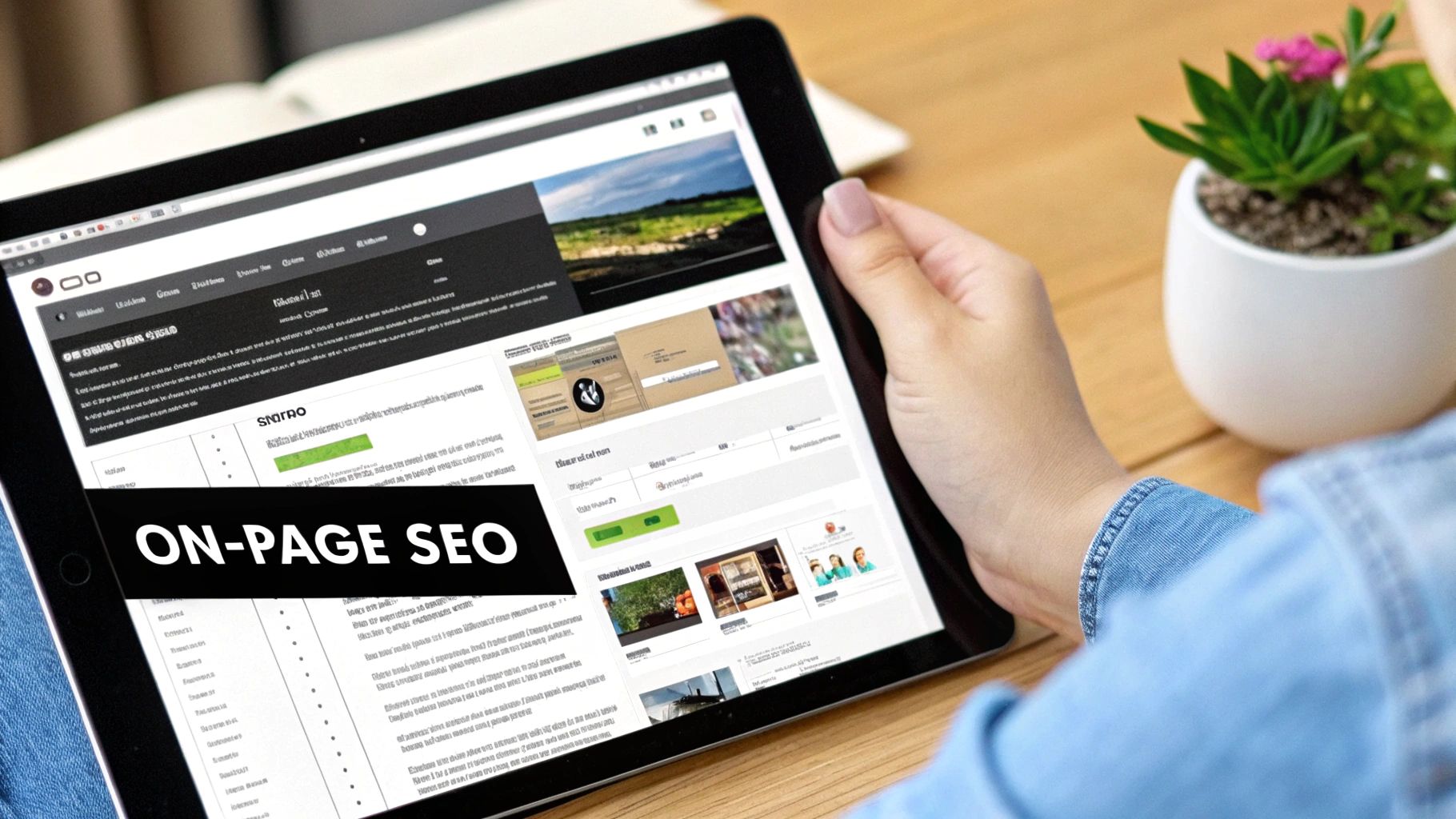
This isn’t just some tech detail to hand off to your developers; it's a core business strategy. The right structure concentrates your brand's power. The wrong one scatters your SEO efforts to the wind, forcing every single location to claw its way up the rankings on its own.
The Big Three Website Structures
When it comes to franchises, you really have three main models to choose from. Each one has major pros and cons that directly affect your SEO.
-
Subdomains (location.brand.com): These act like loosely connected, separate websites. While they give franchisees a lot of flexibility, Google often treats them as separate entities. This means the hard-earned authority of your main corporate site doesn't automatically flow down to each location, putting them at a huge disadvantage from day one.
-
Microsites (brandnamelocation.com): This means creating a totally separate website and domain for each franchise. I’ll be blunt: this is almost always a terrible idea. It completely cuts the cord to the parent brand's authority, creating a massive, inefficient uphill battle for every franchisee.
-
Subdirectories (brand.com/location): This structure places all location pages inside a folder on the main corporate domain. For franchise SEO, this is overwhelmingly the best way to go. It keeps every location under one powerful, authoritative digital roof.
Why Subdirectories Are Almost Always the Answer
Think of your website's domain authority as a deep reservoir of water. When you use subdirectories, every location gets to drink from that same powerful reservoir your corporate brand has spent years filling. With subdomains or microsites, each franchisee is handed a shovel and told to start digging their own well. It’s just not a fair fight.
Let's look at a real-world scenario. Imagine a national home services franchise called "FixItRight."
| Structure Type | Example URL | SEO Implication |
|---|---|---|
| Subdirectory | fixitright.com/dallas-tx |
WINNER: The Dallas page directly benefits from the years of authority built by fixitright.com. All links to the main site help all location pages. |
| Subdomain | dallas.fixitright.com |
RISKY: Google may see this as a separate site. The Dallas location must build its own backlink profile and authority from scratch. |
| Microsite | fixitrightdallas.com |
AVOID: This completely disconnects the location from the parent brand's SEO power. It creates brand confusion and fractures all marketing efforts. |
In Google's eyes, subdirectories create a single, interconnected brand. This structure signals that you're one strong company with many service points, not dozens of disconnected small businesses. This shared strength makes it far easier for each individual location to rank in its local market.
The SEO consensus is crystal clear: subdirectories consolidate authority and pass link equity from the main domain to every location page. This structure gives each new franchisee a massive head start in local search rankings that subdomains just can't compete with.
Making Your Structure Work Even Harder
Just choosing subdirectories is step one. The next move is to optimize that structure to give Google every possible signal about each specific location.
This means each location page (brand.com/location-name) needs to be more than just a landing page. It should function like a "mini-site" for that franchisee. We're talking unique content, local photos, customer testimonials, and—most critically—its own local business schema markup. This structured data explicitly tells search engines the precise name, address, phone number, and business hours for that specific location, leaving no room for confusion. For example, the schema on the brand.com/seattle page will have different coordinates and a different phone number than the schema on the brand.com/tacoma page.
Of course, with a large network of franchisees, managing all these pages becomes a real challenge. For franchises running on WordPress, knowing how to effectively manage multiple WordPress sites is crucial for maintaining consistent SEO and rolling out updates efficiently. Centralized control ensures that technical best practices, like mobile-first design and site speed optimization, are implemented everywhere, giving customers a flawless experience no matter which location page they land on. This solid foundation is what allows your SEO for franchise websites to scale as you grow.
Creating Content That Wins Nationally and Locally
In franchise marketing, you're constantly playing a tug-of-war with your content. You need to build a powerful national brand, but you also have to speak directly to a customer searching for your service in their own neighborhood. Nailing this balance—creating content that serves both the corporate brand and the local franchisee—is a huge piece of the puzzle for successful franchise SEO.
The goal isn't to pick a side, but to develop a powerful hybrid content model. Corporate builds the authoritative foundation, and franchisees are empowered to add that authentic local flavor that both search engines and customers are looking for. When you get it right, this synergy turns a potential weak spot into a massive competitive advantage.
Building Corporate Authority with Foundational Content
At the corporate level, your primary content goal is to scream E-E-A-T from the rooftops: Experience, Expertise, Authoritativeness, and Trustworthiness. This is the bedrock of your brand's credibility. High-level, authoritative content signals to Google that your brand is a leader in its industry, and that authority trickles down to benefit every single franchisee.
Think of these as your brand’s "national assets." These are the high-value content pieces that an individual franchisee just doesn't have the time or resources to create on their own.
- Comprehensive Industry Reports: Publish data-driven reports or white papers on industry trends. A national HVAC franchise, for instance, could release an annual report on "The Top 5 Most Energy-Efficient HVAC Systems for Homeowners."
- Detailed "How-To" Guides: Create the definitive guide related to your services, establishing your brand as the go-to expert. A cleaning service franchise might create an "Ultimate Guide to Allergen-Free Home Cleaning," complete with printable checklists.
- Franchisee Success Stories: Feature in-depth interviews with your top-performing franchisees. This not only builds trust with potential new owners but also showcases the real-world success of your business model. For example, a video testimonial from a 10-year franchisee is powerful social proof.
This kind of pillar content builds topical authority, signaling to search engines that your website is a primary source of information for your niche.
The most effective national content doesn't just sell—it educates and informs. When your corporate site becomes a respected resource, the entire network gets a boost in authority and trust. That's how you build a rock-solid brand reputation online.
Empowering Franchisees with Localized Content Tools
Once you've laid that strong corporate foundation, the next move is to empower your local owners to bring that authority to life at the community level. The secret is giving them the tools and templates to create authentic local content without going off-brand or needing a marketing degree.
This is where your franchisees become your greatest content asset. Here’s how you can equip them for success.
Practical Tools for Hyper-Local Content
Instead of a strict "hands-off" policy, you need to provide a flexible framework. Your franchisees know their communities better than anyone at corporate, so let them showcase that expertise.
- Customizable Blog Templates: Give them pre-approved blog templates for common local topics. For a fast-food franchise, this could be a template for "Sponsoring the Local High School Football Team" or "Our Favorite Local Summer Events." They just fill in the specific, local details like team names and event dates.
- "Meet the Local Team" Pages: Create a standardized but customizable page template where owners can upload photos and short bios of their staff. This puts a human face on the local business and builds immense trust. A customer seeing the face of the manager they speak with on the phone is a powerful connection.
- Galleries of Local Work: For service-based franchises, provide an easy-to-use gallery feature on their location page. A landscaping franchisee in Arizona can show off desert-friendly projects, while one in Vermont can highlight lush gardens. This authenticates their local expertise far better than stock photos ever could.
This hybrid approach ensures brand consistency while tapping into the power of genuine, local authenticity. The result is a content strategy that feels unified at the national level yet deeply relevant and personal where it matters most—in the local community. To get this balance just right, you might find our guide on strategic content marketing for franchise growth useful. This combination is what truly makes SEO for franchise websites a success.
Measuring SEO Performance Across Your Network
Let's be honest: without clear data, any SEO strategy is just a guessing game. What really separates a good franchise SEO program from a great one is the ability to effectively track performance across your entire network. But don't worry, this doesn't mean you have to drown in spreadsheets. The secret is building a centralized system that tells you what's actually working.
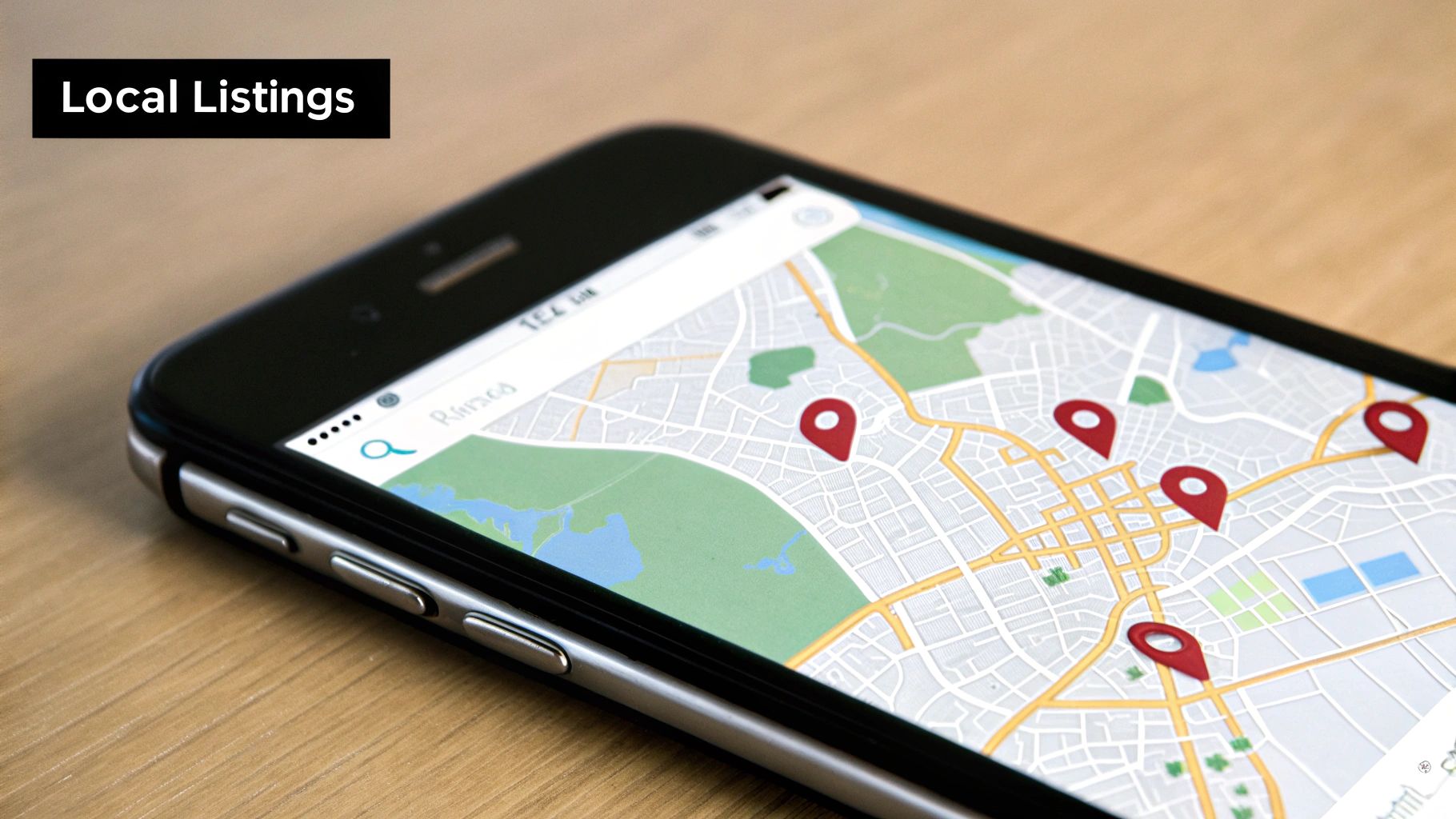
The goal here is to get away from messy, isolated reports and create a single source of truth. This is how you prove the value of your SEO efforts to both corporate stakeholders and individual franchisees, keeping everyone on the same page and motivated.
Building a Centralized Reporting Dashboard
Your first move is to consolidate all your data. Tools like Google Analytics 4 (GA4) and Google Looker Studio (which used to be Data Studio) are perfect for this job. They let you pull data from multiple sources—like your main website and all your individual Google Business Profiles—into one clean, interactive dashboard.
Picture a home services franchise with 75 locations. Instead of the nightmare of sending out 75 separate, clunky reports, you build one master dashboard in Looker Studio. At the top, you can add a simple dropdown filter. Now, a regional manager or a corporate team member can select any specific location and see all its key data in an instant. Even better, you can give each franchisee read-only access to their specific data, empowering them with knowledge. Simple.
Moving Beyond Vanity Metrics
One of the biggest mistakes I see in franchise reporting is a fixation on vanity metrics. Things like total website traffic or keyword rankings for broad, generic terms might look impressive, but they don't tell you if your SEO for franchise websites is actually generating business.
Instead, your dashboard needs to shine a spotlight on the Key Performance Indicators (KPIs) that translate directly to revenue. These are the actions that show a customer is ready to pull out their wallet.
- Google Business Profile Clicks: How many people are clicking to call, requesting directions, or visiting a location's webpage straight from the map listing? This is gold.
- Local Lead Form Submissions: Are people actually filling out the "Request an Estimate" forms on the individual location pages?
- Local Phone Call Tracking: Using dynamic number insertion, you can see exactly how many phone calls come from organic search for each specific franchisee.
- "Find a Location" Page Usage: How many visitors successfully use your store locator to find their nearest franchisee? Tracking the exit rate on this page can also tell you if it's easy to use.
The real measure of success isn't just ranking #1 for a term; it's the number of phone calls and direction requests that ranking generates for your franchisees. Shifting your focus to these conversion-focused actions is how you prove tangible ROI.
Creating a Franchisee Leaderboard
A fantastic way to visualize performance and spark some friendly competition is to create a "Franchisee Leaderboard" right inside your dashboard. This is usually just a simple table that ranks locations based on the KPIs that matter most, giving everyone a clear snapshot of who's knocking it out of the park.
For a restaurant franchise, a leaderboard might look something like this:
| Franchise Location | Organic Traffic (MoM Growth) | GBP Direction Requests | GBP Phone Calls |
|---|---|---|---|
| Miami, FL | +18% | 1,204 | 850 |
| Austin, TX | +12% | 980 | 712 |
| Denver, CO | +9% | 755 | 634 |
This kind of report is incredibly powerful. It doesn't just celebrate your top performers; it also helps you instantly spot underperforming locations that might need a bit more support or training. It turns abstract SEO data into a clear, understandable business tool.
Demonstrating this value is a core part of managing your marketing efforts, and you can explore more about how to properly allocate your franchise marketing budget to support these data-driven strategies. By measuring what matters, you create a transparent system that proves the value of your work and drives real growth across the entire network.
Common Questions About Franchise SEO
When you're wrestling with SEO for franchise websites, the same questions tend to pop up again and again. Getting these answers right is the key to making sure your corporate strategy and your franchisees' on-the-ground needs actually line up.
Let's dive into some of the most common challenges and sticking points we see franchise marketers face every day. The goal here is to give you clear, practical advice so you can sidestep those costly mistakes.
Should Each Franchise Location Have Its Own Social Media?
Yes, absolutely. While the corporate office should definitely own the main brand accounts (like on X and LinkedIn), giving franchisees local pages on platforms like Facebook and Instagram is a game-changer for genuine community connection.
Think about it. A national feed can't—and shouldn't—post about a local store's team lunch, a sponsorship of the town's Little League, or a flash sale just for that neighborhood. These local accounts are perfect for that kind of authentic, highly relevant content that makes a brand feel like a neighbor.
The trick is to maintain brand control while allowing for this local personality. You have to equip your franchisees with:
- Crystal-clear brand guidelines that cover everything from logo use to the right tone of voice.
- Simple content templates for common posts like holiday hours or special offers, which can be created in a tool like Canva.
- A bit of training on social media best practices and how to handle customer interactions, like responding to negative comments.
When those local social pages link back to their specific location page on your main site, you also get a nice little SEO boost. It sends valuable signals to search engines, reinforcing that franchisee’s ties to their local community.
How Do We Handle a Franchisee Doing Their Own SEO?
This is an incredibly common scenario, and it almost always comes from a good place. A franchisee wants to succeed and is trying to take initiative. The first step is always education, not a heavy-handed shutdown.
The owner probably has no idea that some "rogue" SEO tactics—like building a second, duplicate website or buying a bunch of spammy, low-quality links—can actively damage not just their own location but the entire brand's domain authority. Show them the data. Walk them through the centralized performance dashboard to demonstrate its value and the progress you're making for them.
A fantastic way to handle this is to channel their enthusiasm productively. Set up a co-op program where corporate matches funds for pre-approved, brand-safe local marketing or SEO vendors. This turns a potential problem into a powerful partnership, making sure their investment boosts everyone's success.
What Is the Biggest SEO Mistake Franchises Make?
Without question, the single most damaging mistake we see is content duplication. It's rampant. Many franchises just copy and paste the same service descriptions, "about us" sections, and other content across every location page, doing a simple find-and-replace for the city name.
Search engines are far too smart for that. They immediately spot this as low-effort, thin content. The result? They struggle to figure out which of the nearly identical pages to rank, and often, they end up filtering most of them out of the search results entirely. It's a huge reason why some of your locations might seem invisible online.
The fix isn't easy, but it's non-negotiable for real success: you have to create genuinely unique content for each location page. That means including things like:
- Unique service descriptions that might highlight local specialties (e.g., "Hurricane-proof window installation in Miami").
- Testimonials and case studies from real customers in that area.
- Photos and bios of the local team, mentioning their local credentials or community involvement.
- Mentions of local landmarks, community events, or neighborhood-specific details ("Proudly serving the Oak Lawn community…").
This is one of the most critical issues we tackle when we talk about franchise marketing. You can learn more by checking out our guide on common franchise marketing mistakes and how to avoid them. Overcoming this one hurdle is a massive step forward.
How Long Does It Take to See SEO Results?
Franchise SEO is a marathon, not a sprint. Setting realistic expectations with everyone—from corporate stakeholders to individual franchisees—is absolutely essential for keeping everyone on board for the long haul.
You can often spot some encouraging early wins in local map pack rankings within 2-3 months. This usually follows foundational work like cleaning up your NAP (Name, Address, Phone) data and fully optimizing all your Google Business Profiles. Celebrate these wins!
But getting strong, stable organic rankings for your more competitive service and product keywords? That typically takes 6-12 months, sometimes longer. The timeline depends heavily on how competitive your industry is, your website's starting authority, and how consistently you work at it. While you wait for those broader organic results to build, focus on tracking leading indicators like improved clicks and engagement from your Google Business Profiles to show momentum.
Ready to stop guessing and start implementing an SEO strategy that drives real results for every one of your locations? The team at Latitude Park specializes in building powerful, cohesive SEO programs for franchises that boost both national brand authority and local franchisee revenue. Schedule a free consultation with us today!


